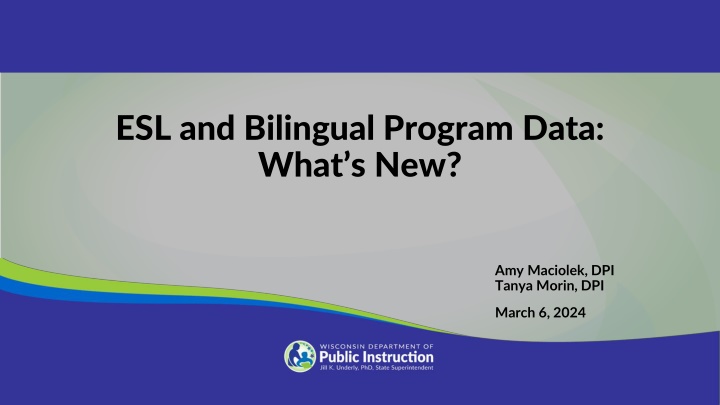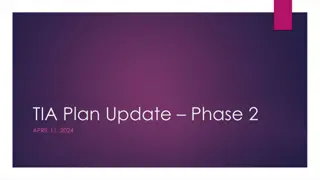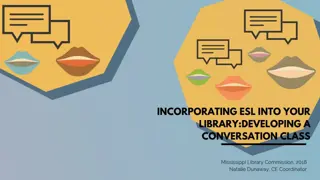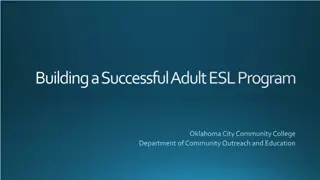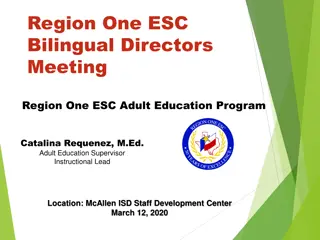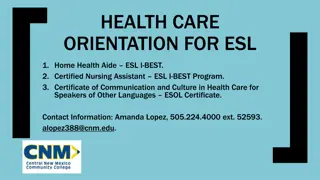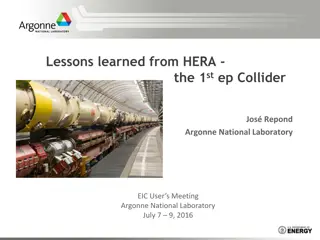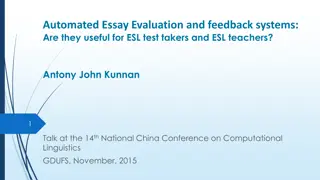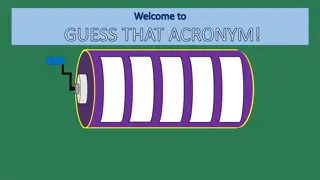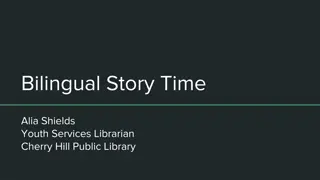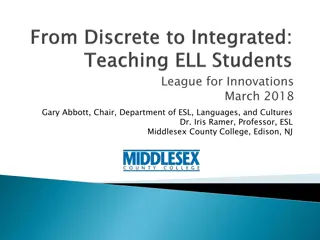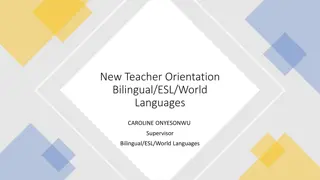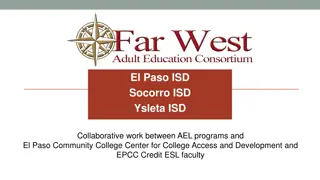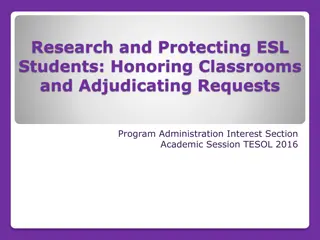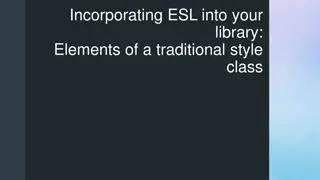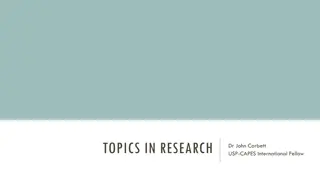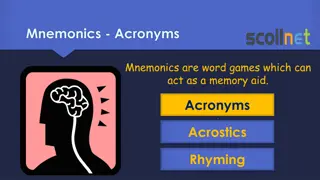Insights into ESL & Bilingual Program Data: What's New and Essential Acronyms Explained
Explore key updates and information on ESL and bilingual programs, including session goals, presenter details, data reporting for language learners, and understanding English Learner acronyms. Uncover needs, strengths, and challenges of English Learner students to enhance educational support.
Download Presentation

Please find below an Image/Link to download the presentation.
The content on the website is provided AS IS for your information and personal use only. It may not be sold, licensed, or shared on other websites without obtaining consent from the author.If you encounter any issues during the download, it is possible that the publisher has removed the file from their server.
You are allowed to download the files provided on this website for personal or commercial use, subject to the condition that they are used lawfully. All files are the property of their respective owners.
The content on the website is provided AS IS for your information and personal use only. It may not be sold, licensed, or shared on other websites without obtaining consent from the author.
E N D
Presentation Transcript
ESL and Bilingual Program Data: What s New? Amy Maciolek, DPI Tanya Morin, DPI March 6, 2024
Meet Your Presenters Meet Your Presenters Amy Maciolek Multilingual Learners and Title III Tanya Morin Dual Language and Bilingual-Bicultural Education
Whos in the room? Who s in the room? How familiar are you with reporting data on language learners?
Session Goals Session Goals Understand who English Learners (ELs) are Understand why data is collected for ELs Understand what data is collected for ELs (EL Data Elements) Explore Language Instruction/LIEP data Become familiar with LIEP crosswalk Q&A
Center English Learners with Data Center English Learners with Data You are tasked with uncovering the needs/strengths and successes/challenges of English Learner students in your district. What information do you need to collect?
English Learner Acronyms English Learner Acronyms ELDS EL Exited ELP or ELD DLL LIEP BLBC ML/MLL ESL ACCESS for ELLs LOTE WIDA HLS Screener Photo by Farzad Mohsenvand on Unsplash Farzad Mohsenvand Unsplash SLIPA LTEL timer: https://www.youtube.com/watch?v=CH50zuS8DD0y timer: https://www.youtube.com/watch?v=CH50zuS8DD0y timer: https://www.youtube.com/watch?v=CH50zuS8DD0y
English Learner Acronyms Explained English Learner Acronyms Explained EL- English Learner ELDS- English Language Development Standards Exited- The time when an EL reaches native proficiency and is no longer served in an Language program. ELP/D - English Language Proficiency/Development DLL- Dual Language Learner ML/MLL - Multilingual Learners (Emergent Bilingual) LIEP/Crosswalk - Language Instruction Education Program /Document ACCESS for ELLs - Assessing Comprehension and Communication in English State-to-State for English Language Learners BLBC - Bilingual-Bicultural Program ESL - English as a Second Language LOTE - Language other than English WIDA- annual proficiency assessment organization HLS - Home Language Survey Screener-Initial Language Proficiency Screener used for Identification SLIPA- Student Language Instruction Program Association LTEL- Long-term English Learner
English Learner: Legal Definition English Learner: Legal Definition Aged 3-21 Enrolled/preparing to enroll in elementary or secondary school Not born in U.S. or whose native language is a language other than English AND Where difficulties in speaking, reading, writing, or understanding English language may be sufficient to deny them: Ability to meet State s proficient level of achievement on State assessment Ability to successfully achieve in classrooms where language of instruction is English; or Opportunity to participate fully in society
Wisconsin English learners 51,638 represents 6.7 % of the current enrolled students reported. (SY21-22: 49,812) Total School Population: 771,098 Nearly 80% of ELs identify Spanish as their first language. 2022-2023 EL Student Population, WISEdash
Why do we collect data? Why do we collect data? Meet reporting requirements Inform research and data analysis for growth Assess program efficacy Measure student academic and linguistic progress Provide systems of support for areas of identified need State-level policy and budget Guide teacher recruitment, training, and retention
Title III: EL Data Reporting Requirements Title III: EL Data Reporting Requirements Title III - Lays out federal reporting requirements for ELs Part of Elementary and Secondary Education Act of 1965 (ESEA), as amended by Every Student Succeeds Act of 2015 (ESSA) Purpose - To help ensure ELs attain English language proficiency and meet state academic standards
What data do we collect for English Learners? What data do we collect for English Learners? Languages Number of ELs Enrolled in the state By ELP assessment administered, EL accountability status, and disability status By assessment participation status assessed for the first time (ELP assessment) By grade level , race and ethnicity program type Not attained EL proficiency within 5 years within initial classification Accountability status Exited status by year Who not exited an LIEP as a result of attaining English Proficiency Graduation rates Language Instruction Education Programs Type of LIEPs Termination of programs Common languages spoken in the state Data for Immigrant Students Number of Immigrant Students Native Language of Immigrant Students Participation of immigrant students in Language Programs # of LEAs receiving funds under this part Number of teachers in Title III Language instruction educational programs (LIEPs) by certification status Number of Former ELs Academic subject assessed proficiency status Disability status Activities Instructional professional development Family Engagement
Turn and Talk: Collaboration Turn and Talk: Collaboration Data collection requires collaboration between data experts and ESL/bilingual program experts Who do you collaborate with to collect and report EL data? What policies/procedures are in place to support collaborative data collection efforts?
Language Proficiency Data Language Proficiency Data Score of 1-4.9 on ELP assessment (ACCESS) = EL Score of 5 = Must exit EL status May exit with score of 4.5-4.9 Exited ELs = ELP code 6 Language Instruction Monitoring Year Content progress for former ELs - 4 years Number of ELs who have not obtained proficiency after 5 consecutive years
Immigrant Children and Youth Immigrant Children and Youth Immigrant Children and Youth under ESEA Section 3201(5): The term immigrant children and youth means individuals who (A) are aged 3 through 21; (B) were not born in any State*; and (C) have not been attending one or more schools in any one or more States for more than 3 full academic years *Each of the 50 states, the District of Columbia, and Commonwealth of Puerto Rico
Immigrant Data Determination/Collection Immigrant Data Determination/Collection To determine whether or not a student meets the Title III definition of an immigrant child and youth, a school and/or district should never directly ask about a student, parent, guardian, or sponsor s citizenship or immigration status or date of entry into the United States upon enrollment For purposes of determining if a student meets the definition of immigrant children and youth under Title III, district staff should request only information about a student s date of birth, place of birth, and prior school enrollment
Immigrant Children and Youth Grant Immigrant Children and Youth Grant Immigrant Children and Youth Grant Grants amounts range from $10,000- $50,000 Individually or with a CESA consortia 5% of Title III allocation Discretionary grants Enhanced opportunities for immigrant children and youth
Native or Primary Language Native or Primary Language Native language: Language or dialect first learned by an individual or first used by parent/guardian with child; often referred to as primary language Required field for WISEdata records if: English Language Proficiency Code = 1-5 OR Immigrant (Title III) = Y (Regardless of Grade Level) School Districts should identify first/native language using a list of 3-digit alpha codes for languages
Turn and Talk: Language Learners Turn and Talk: Language Learners Who are the EL students in your school or district? Are many of your ELs also immigrant students? What are the most common primary languages spoken by EL students?
Todays Data Focus: Today s Data Focus: Language Instruction Services (i.e., LIEPs) Learners for whom data is reported Language Instruction Primary Service Revised LIEP crosswalk and codes
Learners Learners Identified English Learners ELP Code 1-5 Must have an identified LIEP Primary and secondary LIEP, if applicable Non-English Learners Former English Learners (ELP CODE 6) Students who were never identified as English learners (ELP CODE 7) No LIEP reported If participating in a dual language program, reported through World Language Education Program Data
Language Instruction Services Language Instruction Services Language instruction services (LIS) - Data element that describes language instruction educational program (LIEP) an EL is receiving Report each service student is receiving for current reporting period Must indicate primary LIEP Not reported for non-ELs, including former ELs (ELP level 6) Different than Language of Instruction
Language of Instruction Language of Instruction Course-level data element Language used for teaching and learning within the course English as default Data enhancement aimed at better understanding language learning environments DPI Language of Instruction webpage
What is an LIEP? What is an LIEP? Defined in Elementary and Secondary Education Act (ESEA) Language instruction educational program for EL students (Bilingual and/or ESL) Purpose to assist students in: Developing/attaining English proficiency (English Language Proficiency Standards) Meeting challenging state academic content/achievement standards May include instruction in English and student s primary language to facilitate English language development (Other Language proficiency Standards) May include participation of non-ELs if goal is proficiency in English and target language for all students
Reporting LIEP Data Reporting LIEP Data Collected by DPI as part of WISEdata reporting requirements for ELs Collected at student level using program codes Tracked via school information system (SIS) Reported only for ELs May report each service student is receiving for current reporting period. Must indicate primary LIEP
Language Instruction Primary Service Language Instruction Primary Service Data element associated with language instruction True/False indicator Primary LIEP service = One in which student spends majority of time Report only one service as primary *New this year - Can also report secondary LIEP (not required) Language Instruction Data Reporting Language Instruction Primary Service
Language Instruction Beginning/End Dates Language Instruction Beginning/End Dates Month, date and year on which the student first began receiving and language Instruction Month date and year on which the student exited the language instruction program Format: mm/dd/yyyy Language Instruction Data Reporting
Turn and Talk: Strengths and Challenges Turn and Talk: Strengths and Challenges What do you see as your district s biggest strengths in its efforts to collect data related to ELs? What do you see as your district s biggest challenges in its efforts to collect data related to ELs?
2022 LIEP Crosswalk 2022 LIEP Crosswalk LIEP crosswalk lists: LIEPs for ELs in WI Associated reporting codes Released Spring 2022 Used for reporting starting in 22-23 school year Can be accessed here
Data Enhancements Data Enhancements Separate reporting of Caregiver Refusal and No LIEP available data Collect full data set for dual language education programs Create means to identify an primary and secondary LIEP s Ability to track LIEP history for former ELs Design reports to assess LIEP outcomes and growth
Overview of 2022 LIEP Crosswalk Overview of 2022 LIEP Crosswalk Three main sections: Bilingual Programs English as a Second Language (ESL) Programs Missing/Refusal/Other For each LIEP, includes: Name of LIEP and Reporting Codes Description and Learners Standards and Outcomes Federal and State Funding and Plan of Service (POS) Requirements 2022 LIEP Crosswalk
Revised LIEPs Revised LIEPs Bilingual LIEPs ESL LIEPs Missing Dual Language Education - Two-Way Bilingual Content-Based ESL No LIEP Available Sheltered Instruction Caregiver Refusal Dual Language Education- Developmental Bilingual Integrated ESL Other Newcomer ESL Transitional Bilingual - Early Exit Structured English Immersion Transitional Bilingual - Late Exit American Indian Language Bilingual Stand Alone ESL/ELD Heritage Language Bilingual ESL Integrated Self- Contained SPED Newcomer Bilingual Bilingual- Integrated Self-Contained SPED
Crosswalk Organization: Example Crosswalk Organization: Example (1 of 2) (1 of 2) 2022 LIEP Crosswalk
Crosswalk Organization: Example Crosswalk Organization: Example (2 of 2) (2 of 2) 2022 LIEP Crosswalk
Closeup: Models and Codes Closeup: Models and Codes
LIEP Models and Codes (Bilingual) LIEP Models and Codes (Bilingual)
LIEP Models and Codes (ESL) LIEP Models and Codes (ESL)
No LIEP Codes No LIEP Codes
Caregiver Refusal Caregiver Refusal Caregivers have a right to decline or opt their children out of a school district s EL program or out of particular EL services Decision must be knowing and voluntary Upon opting out, students retain their EL status and LEAs must still take affirmative steps and appropriate action in providing access to the educational program Annual proficiency testing is still required Monitoring for two years
LIEP Flowcharts LIEP Flowcharts Decision-making tools Version A: Learner Outcomes Version B: Language of Instruction
LIEP Crosswalk: Explore LIEP Crosswalk: Explore Open and review the 2022 LIEP Crosswalk What are the program models and reporting codes used in your district?
Program Search Program Search 1. What is the program code for the program model in which about 50% of students are native speakers of a target language and 50% are native speakers of English and instruction is provided in both languages? 2. What is the program model name for a program in which an EL educator pushes into a general education classroom and provides support in English? 3. What is the program code used for programs that serve immigrant students in grade 2 or higher from different language groups who have been in the country for one year or less? 2022 LIEP Crosswalk
? ! ? ! What questions do you have? What suggestions do you have?
DPI Reference Resources DPI Reference Resources LIEP Crosswalk (2022 Version) WISEdata Language Instruction Services WISEdata Language Instruction Services FAQs What Can I Teach Resource (2020 Version)
DPI Contacts DPI Contacts Multilingual Learners & Title III Amy Maciolek amy.maciolek@dpi.wi.gov Dual Language/Multilingual & Multicultural Education Tanya Morin tanya.morin@dpi.wi.gov World Language and Global Education Pam Delfosse pamela.delfosse@dpi.wi.gov
Questions? Questions? Thank you! Thank you! Please scan the QR code to provide us with your feedback!
